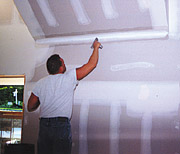
I remember years ago, taping off-angles on tray ceilings with conventional paper tape. This was very time consuming on my sanding and touch-up phase. I would snap a chalk line from point to point and fill any waves with a quickset compound. This sometimes took more than two coats, but the end result was nothing less than a beautiful tray ceiling with all angles appearing to be straight within 1/16 inch.
The tray ceilings, once painted, would look great for several weeks—until small hairline cracks appeared on some of the off-angles. I realized this problem was due to shrinking lumber. Ceilings are framed with larger dimensional lumber, such as 2 by 8, 2 by 10 or 2 by 12. The larger the lumber used, the more severe the cracking was on any off-angles.
Strait-Flex, manufactured by Con-Form, is a product that is used mostly in creating straighter, crack-resistant inside and outside off-angles. When properly installed, the product can save time and money.
Shrinking lumber
Back then, there wasn’t much one could do about these cracks except fix the problem, usually at one’s own expense. Today, things are different. We have products and the knowledge to eliminate these problems, or at least greatly minimize them.Builders are still framing with wet lumber, even during the colder months, in areas of the country where heat is needed. Something must give, especially since heat isn’t applied until the last minute when the taper arrives.
If you are paper taping, your ceiling off-angles will crack. You can eliminate this problem of cracking by installing Strait-Flex on the off-angles. Strait-Flex can sometimes “pop” if improperly installed. We can greatly reduce or altogether eliminate the popping, but first must address the main reasons why Strait-Flex pops.
Since Strait-Flex needs only a slight skim coat over the edge with a lightweight mud, why not install it on the finish coat or on the day you touch up and sand? During colder months, this will allow a minimum of several days of dry heat to pre-shrink the lumber and adequate time during hot summer months to do the same. Those who have climbed into an attic during warm months know what I mean. Contrary to popular belief, you do not need to install Strait-Flex on the first coat. This will also give time to prefill any waves in the framing between the first- and finish-coat days and to prefill any nails or screws that are not covered by the Strait-Flex. This results in a straighter application of the product.
During colder months, don’t be afraid to bump up the heat to 75 degrees during the evening. This will achieve better results in preshrinking the lumber over the minimum temperature of 55 degrees recommended by most joint cement manufacturers.
To address the problem of improper installation
If the fold is not correct when installing the Strait-Flex you will not have a good bond. Remember Strait-Flex, when folded, will retain its own “memory” of the fold before it was installed (sort of like a spring).There are several ways to install Strait-Flex. On smaller runs of 10 feet or less, precut to the desired length to be installed then lay this length on the floor. Fold and then back-fold to the exact angle. If you are not experienced, try a “dry fit” first. As with anything, practice makes perfect.
It is also a good idea, when precutting your lengths, to nip each end of the Strait-Flex to a slight point. This is not necessary on any part that would be covered by a base molding.
For longer runs, precut the lengths of Strait-Flex then apply mud to your angle. Pre-fold the first 4 feet or so. I start by laying the pre-folded section in place with my right hand and continue folding with my left hand, making sure the fold matches the degree of the angle.
After the Strait-Flex is up, make any final adjustments needed to ensure its straightness, then follow by wiping out the excess mud from behind the Strait-Flex. After the mud has dried, usually within a few hours (assuming you pre-filled the nails and screws if you are not using a quickset mud), skim the outside edge with a lightweight mud once, or two times with an all-purpose mud. Never fill the center portion with joist cement. When dry, follow with a light sanding using a sanding sponge.
This system works and has served my customers and me very well.


